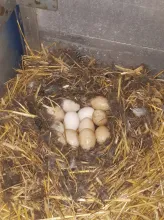
Orinoco Goose (Neochen jubata)
Species name
- Dutch name:
- Orinocogans
- English name:
- Orinoco Goose
- German name:
- Orinokogans
- French name:
- Ouette de l'Or
- Scientific name:
- Neochen jubata
Scientific classification
- Order:
- Anseriformes
- Family:
- Anatidae
- Onderfamilie:
- Tadorninae
- Genus:
- Neochen
Description
- Description:
Male:
The head, neck and breast are a pale grayish-buff with darker mottling and striations along the rear and sides of the neck. The flanks and belly are chestnut; the upper mantle and scapulars are rufous; the bill is black with a hint of pink; the back, rump and tail are greenish-black; the wings are purplish-to greenish-black with a white patch at the base, and the legs are red.Female:
Identical to males But slightly smallerJuvenile:
Have duller plumage than adults.
- Behaviour:
Aggressive in the breeding season and usually found as pairs or family groups. Flocks of up to 20 birds may be seen in the moulting season, rarely larger flocks. Popular but not particularly common in waterfowl collections.
Standard Measurements
- Body Length (cm):
- The male (drake) of the Orinoco Goose measures approximately 61-66 centimeters. The female measures approximately 61-66 centimeters.
- Body Weight (grams):
- The male will weight about 1300-1600 gram. The female will weight about 1225-1545 gram.
The weight is notoriously variable and can only be used as indication!
- Note:
Sheldgeese are generally hardy, and mostly aggressive particularly in the breeding season, so that pairs require a separate pen. A pen for a pair of these birds may be 80% grazing land to 20% water, with a minimum size of 200 square metres for the smaller species (e.g. Orinoco goose) and 300 square metres for the larger species.
Grazing birds, their grass should be supplemented with wheat and pellets outside the breeding season and breeders pellets before and during the breeding season. Additional green food should be provided when there is insufficient grass.
Sheltered nest sites may be needed for species which nest early in the year. Ground-level nest boxes, open to the ground, 50x40x40cm, with a ground level entrance hole and containing e.g. dry grass as nesting material.
Orinoco geese are not particularly hardy and require protection in winter, with a good straw bed available even in autumn. Supplementary feeding is important for breeding. They are more social than other sheldgeese but are sometimes aggressive.
These sheldgeese are rarely bred, although pairs which do breed may be prolific. Close ground cover should be provided for nesting, also kennel or wigwam. Broody or artificial incubation is recommended. Goslings very sensitive to cold and damp and should be kept warm, but are otherwise easy to rear; good rearing meal plus duckweed, and live insects suggested.
Hybrids reported with Common shelduck (Tadorna tadorna) and Egyptian goose (Alopochen aegyptiacus).
- Breeding:
- The female Orinoco Goose usually lays from 6-10 pale brownish cream eggs and incubates them for 28-31 days.
- Artificial incubating:
The ideal relative humidity for incubating most waterfowl eggs is 55% (ground nesters) and 40% (cavity nesters). The temperature is usually 37.4°C. Set ventilation as recommended by the incubator manufacturer. Eggs must be turned, either automatically or by hand, a minimum of 4 times a day. As the duckling develops there is a loss of water from the egg and the air sac gets bigger. In normal development of an egg with a 28-31 days incubation, the air sac occupies about a third of it three days earlier. Cleanliness is vital and ideally eggs should be moved to a separate hatcher at this point, where the humidity should be increased to 65% and even higher once they have pipped internally.
- Bird banding:
- Recommended closed leg band ring size for the Orinoco Goose is 14 mm.The leg band ring can only be applied on a young goose at around 12-14 days old.
- It doesn't matter what leg that you band, but it's good to have a consistent system. Suggested: Left leg = Female, Right leg = Male
- Maintenance food:
-





Lundi Regular with a protein content of 20%, valuable Spirulina and high-quality by-products is optimally balanced in its composition maintenance food for water ornamental fowl of all kinds. Especially green teal and Whistling ducks that are not dependent on a very high protein content, are well supplied.
Lundi Regular contains all the minerals and vitamins in full form that are important for the animals. Therefore also suitable as breeding food.





Floating full food for all sea ducks, green ducks, eider ducks and geese, especially in the moulting and breeding phase ideally suited. Packed with wholesome raw materials, natural vitamins and trace elements, this performance food with a protein content of 30% forms the basis for lifelong vitality.



